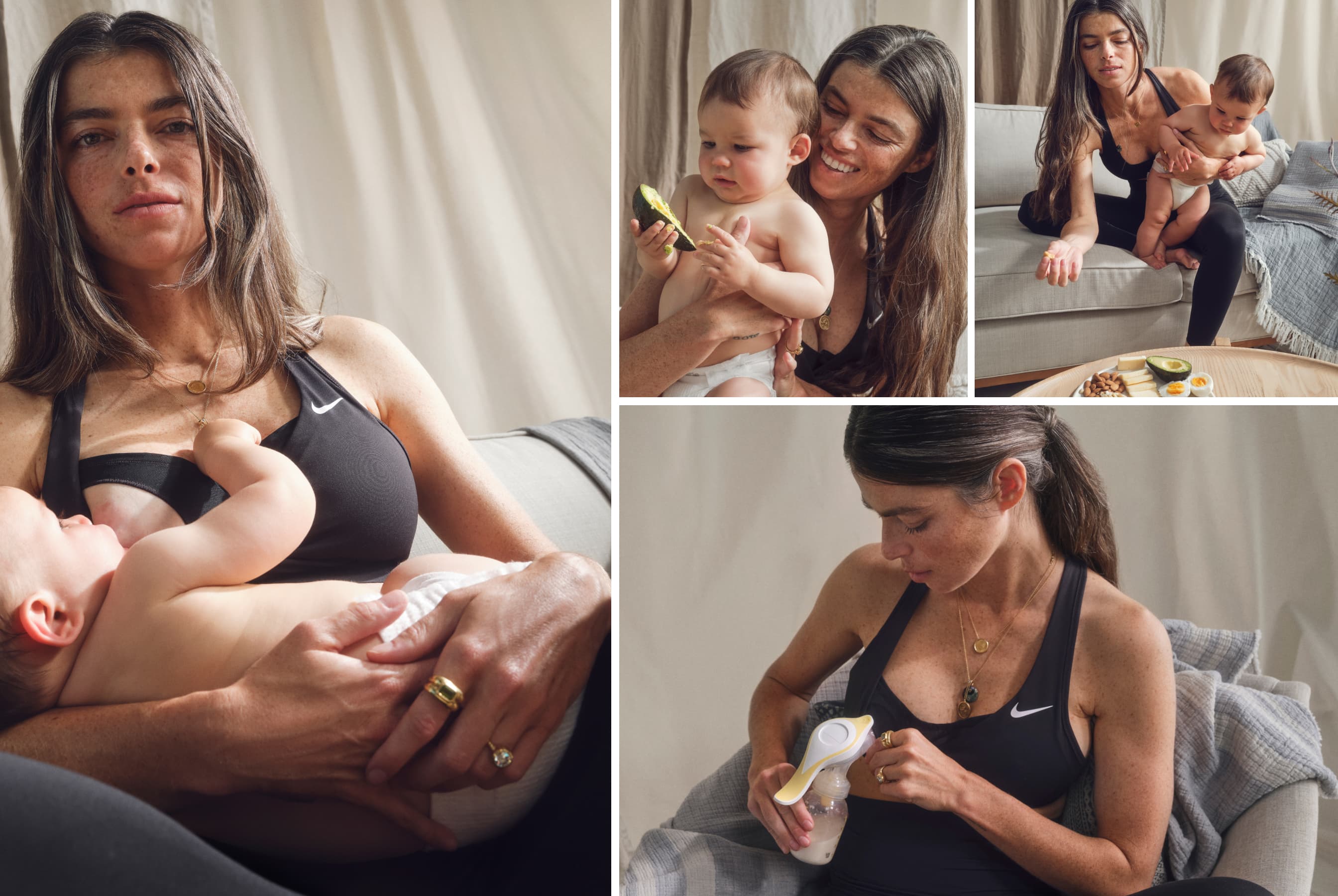Eat Your Way to an Easier Fourth Trimester
This is Nike (M)
Keeping yourself fueled is one of the most helpful — and overlooked — ways to heal and feel better in the early postpartum months. Here’s how.
- What and how you eat after you give birth can make a big difference to the overall function of your postpartum body and mind.
- Right now, you need more fuel than you used to, so upping your overall food and water intake is essential.
- Prioritizing well-rounded meals (whole foods, healthy fats, protein and carbs) can help with recovery, energy levels and mood.
Read on to learn more…

*This content is designed to inform and inspire, but it is not meant to diagnose, treat or give specific medical advice. Always check with your health care provider about how to stay healthy and safe before, during and after pregnancy.
In the early weeks after birth — and even further into your postpartum journey, aka the “fourth trimester” — the right fuel has the power to accelerate recovery, boost your energy, restock lost nutrients and protect your milk supply should you breastfeed, says Ryann Kipping, a registered dietitian nutritionist and the founder of the Prenatal Nutrition Library.
But how are you supposed to nail postpartum nutrition when you might be having trouble nailing, well, anything right now? Let us help.
1. Eat (and drink) more. Way more.
Thought you were ravenous at week 30? Ha. In your first few months postpartum, your body needs all the energy and nutrients to heal and replenish from the stress of pregnancy and childbirth, says Kipping.
Your move? Eat as much as you need to feel satisfied, even if it’s a lot more than you’re used to (yes, two full meals in a row is totally acceptable), says Kipping. That’s the way to go no matter how you’re feeding your baby, but breastfeeding people in particular need 450 to 500 more calories a day than they did prepregnancy, per the American College of Obstetricians and Gynecologists (ACOG), to keep their milk supply as plentiful as possible.
Aim to eat between 71 and 100 grams of protein per day, suggests registered dietitian and international-board-certified lactation consultant Meghan McMillin, the owner of The Lactation Dietitian in Chicago. Beef up (heh) your protein at meals (eat five ounces of chicken instead of three, for example) and include it in all your snacks. Yogurt, nuts and seeds, dried salmon sticks and hard-boiled eggs are a few favorite grab-and-go’s of New York City registered dietitian nutritionist Willow Jarosh, the coauthor of Healthy, Happy Pregnancy Cookbook.
And don’t forget water, a must-have for healing and maintaining a healthy milk supply, says McMillin. Drink as much as you need to never feel thirsty, says Amanda Williams, MD, a board-certified ob-gyn based in Oakland, California, and member of the Nike (M)ove Like a Mother advisory board. Stash a full bottle of water in the bedroom, car, nursery, etc., so you always have one within arm’s reach, recommends Jarosh. And, pro tip, choose bottles with straws or sports tops so you can sip with one hand.
2. Prioritize the (re)building blocks.
Let’s be clear, eating and drinking enough right now is enough. But if you’ve got the time and energy — or help with shopping and cooking — get some extra collagen and iron onto your plate.
Collagen, which makes up skin, cartilage and muscle, can help tissue heal postpartum, says McMillin. Get it from slow-cooked, meaty meals like beef stews and pot roasts, which feel cozy and are easy to make in a Crock-Pot — big bonuses when you’re in recovery and new-parent mode, says McMillin, who recommends prioritizing whole foods over supplements, trendy as they may be. If you’re plant-based, load up on vitamin C (think kiwi and bell peppers) and zinc (found in beans and pumpkin seeds), which can help boost your body’s own collagen production.
Also, if you had low iron levels during pregnancy, lost a lot of blood giving birth, or have a potentially low milk supply (all common, BTW), eat a serving of iron-rich food at almost every meal for the first month, then a serving every day, McMillin and Dr Williams agree. Falling short can lead to fatigue, irritability and headaches, which no one needs ever, let alone now. Red meat is the best source, says Dr Williams, but you can also get some from dark, leafy greens and lentils.

3. Don’t rely on liquid luck.
No one can blame you for wanting to pound coffee after dealing with a newborn sleep schedule. And while you can totally still enjoy your usual latte, think twice before ordering a venti: Jarosh recommends considering food your first go-to for an energy boost, primarily because caffeine can suppress your appetite. Breastfeeding parents might want to stick to no more than 200 milligrams of caffeine per day. Higher amounts may make for a fussy, jittery baby and impact your milk’s iron content, says Jarosh.
And sorry, but go easy on the alcohol too. Booze can reduce REM sleep, which just adds insult to injury when you’re already deprived, says Jarosh. And a note for breastfeeders: If you do imbibe, nurse or pump right before and wait at least two hours after your last drink to nurse or pump again, says Jarosh (ACOG agrees).
4. Nourish your mind.
If you’re in it, we don’t need to tell you that the fourth trimester can be really tough mentally and emotionally. Food can’t fix that, but it can help.
Focus on whole foods and balance each meal with one-third protein, one-third carbs and one-third healthy fats, with fruits and veggies throughout the day, says Jarosh. This combo can help keep your blood sugar stable and your mood and energy more consistently up, she explains. PSA: If you’re worried you are feeling too low too often, reach out to a therapist, stat.
5. Get creative.
When you’ve got a little one napping, nursing or just hanging out in your arms, foods you can hold in one hand come in clutch.
Stock up on pita pockets, which you can stuff with sliced steak or tofu and veggies, tuna salad or PB&J, says Jarosh. You can also make and freeze batches of breakfast sandwiches (think an English muffin with egg, ham and cheese) and energy balls (just roll together a few simple ingredients like oats, nut butter and chia seeds and pop them in the fridge), adds Kipping.
6. Let your body lead the way.
Parenthood is a constant lesson in flexibility — and taking a similar approach to eating will do you good. That means letting your body’s cues tell you when, what and how much to eat instead of relying on schedules or numbers, says Kipping.
By regularly checking in with and listening to your body, you’ll be better equipped to honor upticks in appetite that might come with, say, easing back into exercise, or dips that come with weaning your baby, says Kipping.
This more fluid, intuitive eating style might be a big shift if structure was more your jam pre-parenthood. But hey, if you need proof that your body knows what it’s doing, look to the little one right there next to you.
Words: Lauren Del Turco
Photography: Vivian Kim
CHECK IT OUT
Want more guidance as you navigate motherhood? Start the Nike (M)ove Like a Mother program in the Nike Training Club app for postpartum workouts, wellness advice and more.




